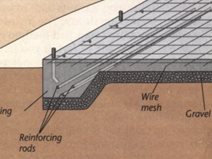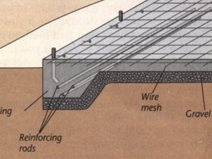Slab foundations are types of foundations used in the construction of low-rise buildings. They are identical to slab foundations, but present small changes in the place where the loads are applied.
Instead of building a separate foundation, using the slab as the base of the building is more beneficial in several ways. However, important factors must be taken into consideration when planning and constructing slab foundations.
- The weight of the superstructure must rest on the slab foundations.
- Soil condition.
- Soil compaction. Because these foundations are designed for uniform loads, varying settlements can lead to serious problems.
What are slab foundations?
O Types of foundations Use the improved slab as the base of the structure.
Parts or the entire structure is built on slab foundations. Reinforcements are placed in the sections of the plate where the load is applied.
In general, this is best suited for one- or two-story buildings. The greater the load, the greater the stress applied to the foundation. So we need a higher foundation area. In this case, the foundation along the wall can become a strip foundation.
Therefore, reinforcement in the area of applied loads can be done as long as only the applied loads are minor and the condition of the soil is good.
Types of slab foundations
Slab foundations are categorized based on improvements made to the slab to increase its rigidity, thereby increasing load capacity when higher linear loads are applied.
When the plate thickness increases due to increased load, it becomes a mat base where a large reinforcing area is required.
- Build on a slab as a base
In this method the structure can be built on the slab. The wall is built on a slab. An important factor in the construction of this type of structure is the load capacity of the slab.
The ground wall can usually be built over the slab without modification. However, attention must be paid to the reinforcement arrangement.
If necessary, additional reinforcement of the walls of the construction site can be provided.
- Construction of a reinforced slab as a foundation (change the slab section if necessary)
An increase in wall load and weak subsurface conditions lead to slab failure due to insufficient static load capacity.
By changing the cross-section of the roof at appropriate points, the rigidity of the roof is improved and the load capacity increases significantly.


This can be done either on the edge of the plate or in the middle of the plate. The plate thickness is increased at the relevant point and returned to the original plate thickness.
Reinforcement is also reinforced in these places. If necessary, an upper reinforcing mesh is provided, at least partially, at these points.
How to Design Slab Foundations
As the low structure is built on slabs, there are no supports protruding from the slab. If present, they cannot be considered slab foundations. They could be considered a slab foundation.
The loads exerted by the walls are generally uniform. However, for conical walls, the applied load is not equal along the wall. Therefore, we consider the applied load and its variation in the design.
We usually modify the slab and insert a section similar to the beams. It can be modeled as a beam on an elastic base. There are many computer programs that can be used for this. The floor can be shaped based on its capacity. The standard penetration value (SPT), the allowable bearing capacity, etc. can be used to shape soil. Underground reaction can be calculated from these parameters and used for modeling.
Advantages of slab foundations
- Cheap
- Quick Setup
- There is no space between the plate and the floor. There is no room for cavities.
- As the floor becomes the base, floor formwork costs are also eliminated.
Disadvantages of slab foundations
- As the cables are laid beneath the slab, maintenance issues arise.
- Not suitable for higher loads
- Due to the different settlements, there is the possibility of cracks forming.
Related articles
- pillar foundation
- Foundations
- Deep foundations
- Foundation failure
- support
- Eccentrically loaded foundations
- Shallow foundation failure
- Pile slab foundations
- mat base
- Foundation pile
- Driven pile foundations
- Pile foundations
- Buoyancy pressure in foundations
- How to determine the type of foundation
- Excavation for foundation
- Foundation waterproofing
- Laying shallow foundations
- Underwater concrete

